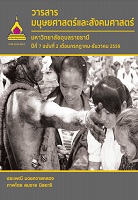ประเพณีแซนโฏนตา: การสืบทอดและการดำรงอยู่ในบริบทพื้นที่ดั้งเดิม
Main Article Content
บทคัดย่อ
บทความนี้มีวัตถุประสงค์เพื่อศึกษาการสืบทอดและการดำรงอยู่ของงานบุญ/ประเพณีแซนโฎนตา หรือ “บ็อน (แค) เบ็ณฑ์” ในชุมชนชาวไทยเชื้อสายเขมรปัจจุบันของหมู่บ้านปรือเกียน ต.นอกเมือง อ.เมือง จ.สุรินทร์ โดยมีสมมติฐานว่า ชุมชนชาวไทยเชื้อสายเขมรหมู่บ้านแห่งนี้ มีความพยายามรักษาและสืบทอดประเพณีประเพณีแซนโฏนตา โดยคงองค์ประกอบหลักและสาระสำคัญตามฐานความเชื่อเดิม แต่มีการดัดแปลงรูปแบบบางอย่างตามปัจจัยที่มากระทบ ผู้วิจัยเก็บข้อมูล 2 แหล่ง คือ เอกสาร และลงพื้นที่ภาคสนามในปี พ.ศ.2555-2557 เพื่อสังเกตแบบมีส่วนร่วม และสัมภาษณ์ผู้นำในการประกอบพิธี ผู้นำชุมชนและชาวบ้าน ผลการศึกษาพบว่า ตลอดระยะเวลาตั้งแต่วันขึ้น 15 ค่ำ เดือน 10 จนถึงวันขึ้น 1 ค่ำ เดือน 11 ของทุกปี กิจกรรมทางวัฒนธรรมที่เกี่ยวข้องกับมนุษย์ พุทธศาสนา และผีหรือ ดวงวิญญาณ อันเป็นหัวใจของงานบุญหรือประเพณีแซนโฎนตา ยังคงได้รับการสืบทอดมาอย่างโบราณ นับตั้งแต่การเตรียมงาน พิธี “โซดดารเบ็ณฑ์ตูจ” พิธี“กันซ็อง” พิธี“ฉลองซ็อง” พิธี“แซนโฎนตา” พิธี“จูนโฎนตา” พิธี“จะกันเจอโฎนตา” พิธี“โซดดารเบ็ณฑ์ทม” และ พิธี“จูนโฎนตาหลบสรุก” ทุกกิจกรรมเชื่อมโยงสัมพันธ์กันโดยมีความเชื่อเกี่ยวกับดวงวิญญาณบรรพบุรุษเป็นจุดเชื่อมร้อย ถึงแม้ชาวชุมชนจะพยายามรักษาและสืบทอดภูมิปัญญาจากบรรพชนเพียงใด แต่ปัจจัยภายนอกบางประการ เช่น สภาพเศรษฐกิจ สังคม เวลา สถานที่ และกระแสโลกาภิวัตน์ ฯลฯ มีส่วนทำให้ต้องมีการปรับรูปแบบ ขั้นตอน หรือรายละเอียดของกิจกรรมและพิธีกรรมบางช่วงตอน หากแต่สาระสำคัญของประเพณีที่มุ่งเน้นให้คนที่มีชีวิตอยู่ได้ตอบแทนบุญคุณคนตาย คนเป็น และพุทธศาสนา ผ่านทุกช่วงกิจกรรมยังคงได้รับการรักษาและสืบทอดไว้อย่างมั่นคงตามฐานความเชื่อเดิม ลักษณะเช่นนี้ช่วยตอกย้ำให้เห็นความเข้มแข็งและจิตวิญญาณด้านการอนุรักษ์ของชุมชนชาวไทยเชื้อสายเขมร
This research aimed to study the transmission and existence of Sandontatradition or Bonkaeben performed by the present ethnic group of Thai-Khmer people at Pruekian Village, Nokmueang Sub-district, Mueang District, Surin Province. It was hypothesized that these Thai-Khmer people had endeavored to preserve and transmit the essential aspects and traditional beliefs of Sandontatradition, with some modifications, in response to influential factors. Data were collected from two sources, documents and field work between 2012 and 2014 involving participant observations and interviews with ritual leaders, village heads, and villagers. It was found that every year from the full moon of the tenth lunar month until the first day of the waxing moon of the eleventh lunar month, cultural activities relating to humans, religion, and ghosts or spirits, the heart of Sandonta tradition, were traditionally carried out by Thai-Khmer people. These activities were Soddarbentud, Kansong, Chalongsong, Sandonta, Jundonta, Jakanjerdonta, Soddarbenthom, and Jundontalobsaruk. They were inextricably intertwined in the belief that the ancestors’ spirits were the central entity. Despite Thai-Khmer people’s attempts to maintain their ancestors’ local wisdom, some external factors, such as economy, society, time, place, and globalization, prompted them to adapt some forms, steps, and details of the activities and rituals. However, the essence lies in the gratitude of the living expression through all ritualistic activities to their ancestors, to the living, and to Buddhism. This tradition has been faithfully transmitted and practiced in line with traditional beliefs and reflects the solidarity and conservative spirituality of the Thai-Khmer community.
Article Details
บทความที่ได้รับการตีพิมพ์เป็นลิขสิทธิ์ของวารสารมนุษยศาสตร์และสังคมศาสตร์ มหาวิทยาลัยอุบลราชธานี
ข้อความที่ปรากฏในบทความแต่ละเรื่องในวารสารวิชาการเล่มนี้เป็นความคิดเห็นส่วนตัวของผู้เขียนแต่ละท่านไม่เกี่ยวข้องกับมหาวิทยาลัยอุบลราชธานี และคณาจารย์ท่านอื่นๆในมหาวิทยาลัยฯ แต่อย่างใด ความรับผิดชอบองค์ประกอบทั้งหมดของบทความแต่ละเรื่องเป็นของผู้เขียนแต่ละท่าน หากมีความผิดพลาดใดๆ ผู้เขียนแต่ละท่านจะรับผิดชอบบทความของตนเองแต่ผู้เดียว

